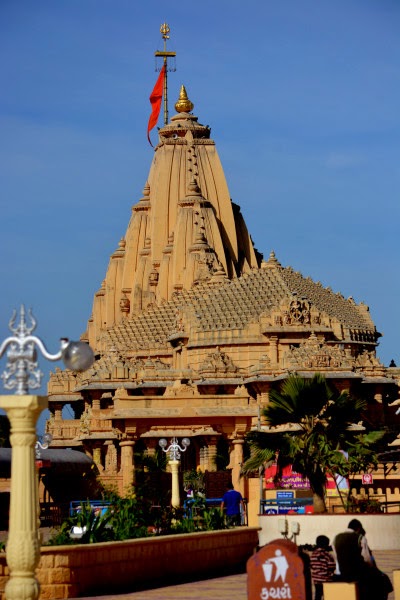Having a made a decision to visit all the shiva temples , the
jyotirlings were on top of the wish list. We had been visiting them over the years.
Hence these updates will be a few years old.
The then President of India, Dr. Rajendra Prasad, did the Pran-Pratistha at the existing temple on 11 May 1951.
Somnath is the first among the twelve Aadi Jyotirlings.
Located on the western
coast of India, itderives its name from the tradition
that the first temple was built by the Moon God in gratitude to the Lord Shiva
for ridding him of a curse placed on him by his father in law. Som in Sanskrit
means “Moon” and hence the name Somnath for the temple built by “Som”.
The
temple is so situated that there is no land from here to the South Pole. An
arrow indicates the direction.
Pauranic legends tell us that the Moon God had built a golden temple, followed by a silver temple by
Ravana, Bhagvan Shree Krishna is believed to have built Somnath temple with
Sandalwood.
The present day temple was the brainchild of Sardar
Vallabhai Patel who had visited Junagadh when he was tasked to build a united
India integrating 500 princely states into India. There is a massive statue of
Sardar Vallabhai Patel in the front looking at the temple with devotion which
he helped build.
The then President of India, Dr. Rajendra Prasad, did the Pran-Pratistha at the existing temple on 11 May 1951.
We reached Ahmedabad from BLR by the Indigo flt at 8.30 am.
We took a cab to Modhera and Rani-Ki –Vav. I will give details of those
magnificent heritage sites in a
different post. We were back
in Ahmedabad by 6.30pm and proceeded to the railway station for our train to
Veraval which is about 7 km from Somnath. The scheduled departure was 10.00 pm
and it left on time to arrive at Veraval at 7.30 am. We took an auto to Somnath
which is a 20 min ride. The auto driver was chatty and friendly and was keen
that we hire him to show us around Somnath. Luck wasn’t on our side as we did
not get a room in the temple guest house. I was unable to see the room but my
impression of the facility from outside was that it was neat and clean and well
maintained.
The aarthi timings are 7.00 am , 12.00 noon and 7.00 pm. The auto
driver suggested that we go to the
temple at 12.00 in time for the noon aarthi. I had been waiting for years to
make this trip and was keen to have the darshan first before I do anything.We
checked into a hotel close to the temple and freshened up and left for the
Somnath Mandir immediately.
The security
is extremely high. No bags/ mobiles/cameras. Though the security personnel were present everywhere they were unobtrusive
and very helpful. One thing which strikes you apart from the overwhelming
security is the cleanliness,, not just here but all of Gujarat.
Everything
about the temple is massive. It has a 7 tiered gopuram which rises about 150 ft with
a flag pole on top of it. It faces east
and is bang on the shores of the Arabian sea. Once you enter the temple there
is a massive courtyard with a beautiful lawn.
The temple
built in the 1950’s is built on the same lines as the old temple built on 56 pillars.
Coming from the south, where one can see “100 pillar mandapam” or a “ 1000
pillar mandapam” I wondered the significance of 56. There is a legend
associated with 56. Krishna had come to the rescue of villagers from the anger
of Indra who had brought torrential rain and floods for 7 days by lifting the
Govardhana giri. The people had taken refuge under the mountain and were saved
from the wrath of Indra. Indra realized his mistake and the futility of taking
on Krishna came to his senses and peace returned to the villages. Kishna is
supposed to have 8 meals/day. 7X8 =56 item menu is prepared for Krishna.
Krishna is supposed to have shed his mortal coil in Somnath. Is that why we
have the Somnath temple built on 56 pillars?
When we enter
the sanctum there is a huge Ganesha on the left and a huge Hanuman on the right
both made of white marble. The floor is white marble inlaid with black granite.
Up ahead is the sanctum sanctorum with a huge lingam. The goddess is behind the
linga and can be seen only if you stand slightly to the side.
An
interesting system allows you do abhishekam to the lingam without entering the
sanctum sanctorum. There is a small opening on the platform in the front where
you pour the abhishekam water (water/milk etc) . The priest pushes a button.
and the milk/ganga jal trickles on the lingam . The pipes are well concealed and appears neat.
Outside is "sakshi Ganapathi" who keeps a record of all the
devotees who visit the Somnath temple.
There is an
open air auditorium for sound and light
show. We missed the show as we had to leave for Dwaraka by late noon. But going
by the pictures on the net it seems like a brilliant effort and a lot has gone
into choreographing the show. I would encourage the readers to stay overnight
and see the program.
Also of
interest is a small gallery displaying old photos of the temple. This is within
the temple complex. There are photos of excavations and the old stones with markings
Dehotsarga also called Balkh Tirth
where Krishna shed his mortal coil is nearby. The tirtha stands at the
confluence of Hiranya, Saraswati and Kapila rivers. Vallabhacharya's Baithak is
also there at PrabhasPatan







No comments:
Post a Comment